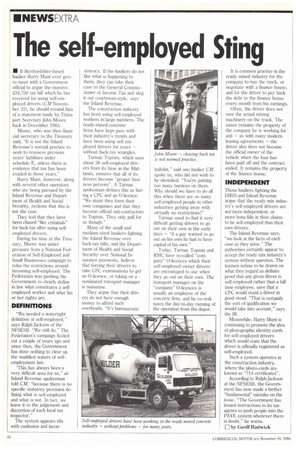The self-employed Sting
Page 26

If you've noticed an error in this article please click here to report it so we can fix it.
• If Hertfordshire-based haulier Harry Mont ever gets to meet with a Government official to argue the massive £24,750 tax bill which he has received for using self-employed drivers (CM November 22), he should remind him of a statement made by Transport Secretary John Moore back in December 1983.
Moore. who was then financial secretary to the Treasury said, "It is not the Inland Revenue's normal practice to seek to reassess previous years' liabilities under schedule E, unless there is evidence that tax has been evaded in those years."
Harry Munt, however, along with several other operators who are being pursued by the Inland Revenue and Department of Health and Social Security, reckons that this is not the case.
They feel that they have been chased "like criminals" for back-tax after using selfemployed drivers.
During his time at the Treasury, Moore was under pressure from a National Federation of Self-Employed and Small Businesses campaign to relax the restrictions around becoming self-employed. The Federation was pushing the Government to clearly define in law what constitutes a selfemployed worker and what his or her rights are.
DEFINITIONS
"We needed a watertight definition of self-employed," says Ralph Jackson of the NFSESB. "We still do." The Federation's campaign fizzled out a couple of years ago and since then, the Government has done nothing to clear up the muddied waters of selfemployment law.
"This has always been a very difficult area for us," an Inland Revenue spokesman told CM, "because there is no specific statutory provision defining what is self-employed and what is not. In fact, we leave it to the judgement and discretion of each local tax inspector."
The system appears rife with confusion and incon sistency. If the hauliers do not like what is happening to them, they can take their case to the General Commissioner of Income Tax and slog it out courtroom-style, says the Inland Revenue.
The construction industry has been using self-employed workers in large numbers. The ready-mixed concrete firms have kept pace with their industry's trends and have been using self employed drivers for years — without back-tax wrangles.
Tarmac Topmix, which uses about 38 self-employed drivers from its base in the Midlands, ensures that all of its drivers become "proper business persons". A Tarmac spokesman defines this as having a CPC and an 0-licence. "We insist they form their own companies and that they become official sub-contractors to Topmix. They only pull for us though."
Many of the small and medium-sized hauliers fighting the Inland Revenue over back-tax bills, and the Department of Health and Social Security over National Insurance payments, believe that forcing their drivers to take CPC examinations to get an 0-licence, or taking on a nominated transport manager is nonsense.
They argue that their drivers do not have enough money to afford such overheads. "It's bureaucratic bullshit," said one haulier CM spoke to, who did not wish to be identified. "You're putting too many burdens on them. Why should we have to do all this when there are so many self-employed people in other industries getting away with virtually no restrictions?"
Tarmac used to find it very difficult getting drivers to go out on their own in the early days — "if a guy wanted to go out on his own he had to have capital of his own."
Today, Tarmac Toprnix and RMC have so-called "company" 0-licences which their self-employed owner drivers are encouraged to use when they go out on their own. The transport manager on the "company" 0-licences is usually an employee of the concrete firm, and he co-ordinates the day-to-day running of the operation from the depot.
It is common practice in the ready mixed industry for the company to buy the truck, or negotiate with a finance house, and for the driver to pay back the debt to the finance house every month from his earnings.
Often, the driver does not own the actual mixing machinery on the truck. The mixer remains the property of the company he is working for and — as with many modern leasing agreements — the driver also does not become the official owner of the vehicle when the loan has been paid off and the contract ended. It remains the property of the finance house.
INDEPENDENT
Those hauliers fighting the DHSS and Inland Revenue argue that the ready mix industry's self-employed drivers are not more independent, or more bona fide in their claims to be self-employed than their own drivers.
The Inland Revenue says, "we look at the facts of each case as they arise." The authorities certainly appear to accept the ready mix industry's system without question. The taxmen refuse to be drawn on what they regard as definite proof that any given driver is self-employed rather than a full time employee, save that a CPC would stand a driver in good stead. "That is certainly the sort of qualification we would take into account," says the IR.
Meanwhile, Harry Munt is continuing to promote the idea of photographic identity cards for self-employed drivers which would state that the driver is officially registered as self-employed.
Such a system operates in the construction industry, where the photo-cards are known as "714 certificates".
According to Ralph Jackson at the NFSESB, the Government has now made a further "fundamental" mistake on the issue. "The Government has issued instructions to its tax agents to push people into the PAYE system wherever there is doubt," he warns.
n by Geoff Hadwick
























































































































